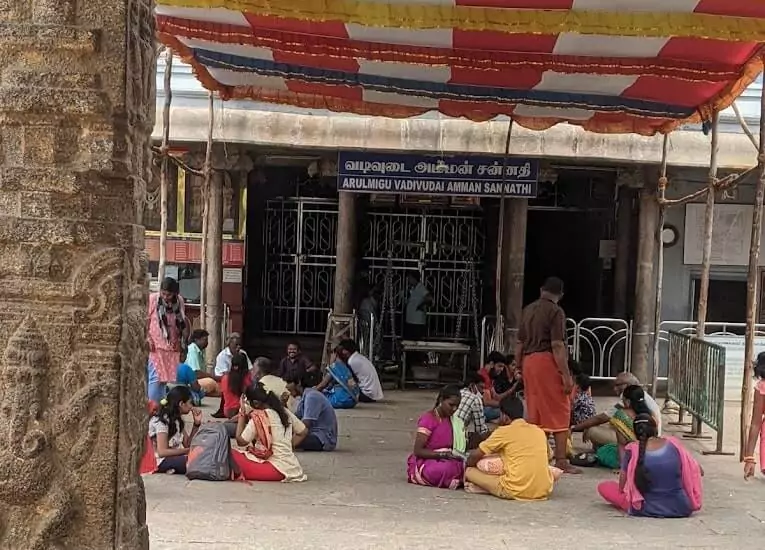- April 5, 2025

Contents
The Thiyagarajar – Vadivudai Amman Temple is located at Therady bus stop in Tiruvottiyur High Road (T. H. Road), Chennai suburb. The Therady bus stop is around 2 km from Tiruvottiyur bus terminus.
The presiding deity is Aadhipureeswarar is in the form of a mud mound covered by an armour. On the day of the full moon of the Tamil month karthigai, the armour is removed and the representation of the god is visible to devotees. The Lord is anointed with punugu, javvadhu, and sampirani oils. There is a Durga shrine in the northern side of the temple. Inside the main temple complex – Just opposite to the main shrine we find the Nataraja shrine and in the koshta is the Ganapati Shrine. The Ganapati is known as Gunalaya Ganapati ( abode of bliss) and as we circumbulate the shrine we find the idol of Adi Shankara -just wee behind the main Shrine inside the Complex. We also find deities like Subrahmanya installed there. The Dakshinamurthy statue is in the Northern Koshta facing south and we come to the Sub complex Shrine of Kali. Adi Shankara is said to have installed a chakra to calm down the Devi and to make her Sowmya roopi( Calm and resplendent). To this day – a select group of Nampoothiri families perform the pooja and aradhana to this Lord and Goddess as desired by Adi Shankara.
The name of the goddess at this temple is Vadivudaiamman alias Tripurasundari. The goddess is housed in a separate shrine inside the Temple complex. Other deities present in the temple include Thiruptheeswarar, Kuzhandhai Eesar, Jaganadhar, Annamalayar, Jambukeswarar, Nagalingar, Meenakshi, Sundareswarar, Sagasralingam, Amirthakandeesar, Gowrieeswarar, and Ekapaadhar. The twenty seven stars of Tamil calendar are believed to have worshipped Shiva in this temple.
The Thiyagarajar – Vadivudai Amman Temple is dedicated to Sri Shiva as Thiyagaraja Swami and Adipurishwarar, and Divine Mother Shakti as Vadivudai Amman.

Brahma is the Hindu god of creation and one of the three primary gods of Hinduism, the other two being Visnu and Siva. He created the Gods and demons – both these groups fight against each other. While the demons, called asuras use muscle power, the Gods called devas use the power of Veda, the sacred texts. Once, two demons, Madhu and Kaithaba tricked the gods to steal the Veda, chopped it to pieces and hid it in the bottom of the sea. Vishnu fought the demons, but could not defeat them. He prayed to Shiva and Parvathi and with the accomplishment, he was able to defeat the demons. He took the form of Matsya, a fish to search the Veda. The recovered Veda from the bottom of the sea was brought to the deity at this temple, who reunited and purified it. The wishing tree of gods, makizha tree, became the sacred tree of the temple.
The temple was the centre of learning, with the halls inside the temple acting as venue for religious discourses in subjects like vyakarna (translation), Somasiddantha (philosophy) and Panini’s grammar. There was a hermitage attached to the temple during 9th century, presided over by Caturananas Pandithar. The temple also had philosophical discourses and expositions on grammar. There are references to recital of Prabhakara, Rudra, Yamala, Purana, Sivadharma, Panchanga and Bharata. Lands were granted to learned scholars and their generation like Vedavritti, Bhattavriti, Vaidyavritti and Archanavritti.
There are a number of inscriptions inside the temple dating back to Pallava period. Sankaracharya, the 8th century scholar in the advaita school of Hinduism is believed to have visited the temple to put down the power of evil. The temple was originally built by Pallavas and later rebuilt by Rajendra Chola I. The inscription dating 954 CE, the fifth year of the Chola king Gandaraditya indicates 90 sheep for burning lamps and ilavilaku, a lamp made in Sri Lanka). The inscriptions dating from 1046 CE reveal that 64 bronze nayanmar statues were installed in the temple. There were equal number of dancing girls called Devadasi in the temple, who were divided into two groups – the valankai dasisdanced for Thyagaraja, while the idangai dasis danced for Vadivudaiamman.
During the reign of the Malik Kafur, much of the temple was destroyed and the bronze idols present now in the temple were installed during the Vijayanagara period of 15th century. A 13th-century inscription indicates the practice of animal sacrifice to the goddess, which continued along with offering intoxicating drink till the early 2000s. Famous saints like Pattinathar, Topeswamigal and Ramalinga Swamigal lived in this town and prayed Thyagaraja in this temple. This place is also home to Thiruvottiyur Thyagayyar who is a carnatic composer and poet.
Shivaratri
Thiru karthigai
Masi magam
Devotees pray for wedding boon and for the welfare of children. Devotees visit this temple to seek fulfillment of the following:-
The Thiyagarajaswamy Vadivudai Amman Temple is open from 6.00 a.m. to 12.00 a.m. and from 4.00 p.m. to 8.30 p.m.
Airport: The nearest airport is Chennai Airport.
Railways: The nearest railway station is Chennai central, Egmore Railways Station.
Road: Tiruvottriyur can be reached from any corner of Chennai city. From beach railway station the place is 12 km far by bus journey.
Thyagaraja Swami – Vadivudai Amman Temple,
Sannathi Street, Tiruvottiyur, Kaladipet,
Tiruchanankuppam, Chennai,
Tamil Nadu Pincode – 600019.